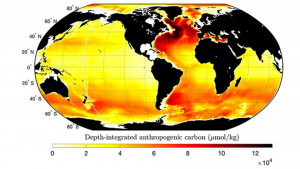According to new research, underwater waves deep below the ocean’s surface play a vital role in the ocean’s carbon sequestration potential.
An international team of researchers, led by the University of Cambridge, the University of Oxford, and the University of California San Diego, analysed how underwater waves as tall as 500 metres affect the carbon sequestration potential of oceans. The team quantified the effect of these waves and other forms of underwater turbulence in the Atlantic Ocean, discovering that their importance is not accurately reflected in the climate models that inform government policy.
The ocean sequesters most of the heat and carbon that is emitted by human activity. However, its carbon sequestration potential depends upon the turbulence in the ocean’s interior, as heat and carbon are either pushed deep into the ocean or pulled toward the surface.
Although these underwater waves are well-known by scientists, their importance in heat and carbon transport is not yet fully understood.
The study, ‘Significance of Diapycnal Mixing Within the Atlantic Meridional Overturning Circulation,’ highlights the importance of underwater waves for the transport of carbon and heat on a global scale.
What role does the Atlantic Meridional Overturning Circulation play in carbon sequestration?
Ocean circulation carries warm water from the tropics to the North Atlantic, where like a giant conveyer belt, they sink and return southwards into the deep ocean. Heat to polar regions is redistributed via ocean circulation, and carbon is relocated to the deep sea, where it can be stored for thousands of years.
“If you were to take a picture of the ocean interior, you would see a lot of complex dynamics at work,” said first author Dr Laura Cimoli from Cambridge’s Department of Applied Mathematics and Theoretical Physics. “Beneath the surface of the water, there are jets, currents, and waves – in the deep ocean, these waves can be up to 500 metres high, but they break just like a wave on a beach.”
“The Atlantic Ocean is special in how it affects the global climate,” said co-author Dr Ali Mashayek from Cambridge’s Department of Earth Sciences. “It has a strong pole-to-pole circulation from its upper reaches to the deep ocean. The water also moves faster at the surface than in the deep ocean.”
Researchers have been investigating whether the AMOC may be a factor in why the Arctic has lost so much ice cover, while some Antarctic ice sheets are growing. A possible explanation for this is that heat absorbed by the ocean in the North Atlantic takes several hundred years to reach the Antarctic.
The movement of heat and carbon is facilitated by turbulence
Now, the team used remote sensing, ship-based measurements, and data from autonomous floats to explore the role of turbulence and large underwater waves in the climate. They found that heat from the North Atlantic can reach the Antarctic much faster than previously thought.

The ocean is made up of different layers, with warmer and lighter water at the top, and colder, denser water at the bottom. Heat and carbon transport usually occur within a particular layer, but they can also move between density layers, bringing deep waters back to the surface. This movement between layers is aided by small-scale turbulence, a phenomenon not fully represented in climate models.
Evidence of small-scale turbulence in the upper branch of circulation was revealed in estimates of mixing from different observational platforms, in agreement with theoretical predictions of oceanic internal waves. The estimates showed that turbulence primarily affects density layers in deep waters moving southward from the North Atlantic to the Southern Ocean, meaning that heat and carbon carried by these water masses have a high chance of being moved across different density levels.
The researchers found that turbulence plays an important role in the ocean’s carbon sequestration potential.
“Climate models do account for turbulence, but mostly in how it affects ocean circulation,” said Cimoli. “But we’ve found that turbulence is vital in its own right, and plays a key role in how much carbon and heat gets absorbed by the ocean and where it gets stored.”
“Many climate models have an overly simplistic representation of the role of micro-scale turbulence, but we’ve shown it’s significant and should be treated with more care,” said Mashayek. “For example, turbulence and its role in ocean circulation exerts control over how much anthropogenic heat reaches the Antarctic Ice Sheet, and the timescale on which that happens.”
The results indicate that turbulence sensors should be installed on global observation arrays and small-scale turbulence should be accounted for in climate models. This will allow scientists to understand the role of turbulence in oceanic carbon sequestration, helping them to make more projections of the future effects of climate change.









